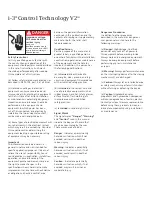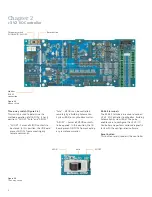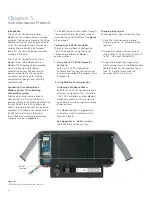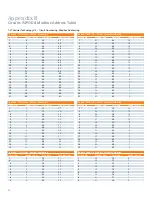
9
Introduction
i-3 V2 I/O Controller provides a set of control
input terminals for wiring devices, such as
wall switches, photocells or occupancy
sensors. These terminals are located in the
input wiring section of the I/O printed
circuit board. There are two types of inputs
provided by these terminals:
•
Switch inputs
– The i-3 V2 I/O Controller
provides up to 20 input connections for
dry or wet (24 VDC) contacts (such as
wall switches, occupancy sensors, etc).
These contact inputs are capable of
acting either independently or in pairs
to turn ON and OFF. The controller can
accept up to 10 three-wire inputs or any
combination of two- and three-wire
inputs until its capacity is reached.
•
Analog I/O
– i-3 V2 I/O Controller
provides two analog input and two
analog output connections to control
0-10V dimming ballast.
There are two Analog Inputs (at TB6 on the
I/O Board) and two Analog Outputs (at TB5).
The Analog Inputs can be used to read any
0 to 10 Volt input value, and the Analog
Outputs can be used to drive out 0 to 10
volts ballast at a maximum of 100 mA each.
In a practical sense, this means that each
Analog Output can drive approximately 50
typical dimming ballasts (assuming each
ballast uses 2 mA – check your ballast
documentation for an actual determination).
The Analog Inputs can be used in any
situation where digital inputs are used.
They are specified by using input numbers
33 and 34, but whether they are “ON” or
“OFF” is more complex. For each analog
input, registers 20 and 21 give the input
value in the range 0-4095. Registers 36
and 37 specify values to be compared
to the Analog Inputs and comparison
operations, to determine whether the
Analog Input is ON or OFF.
Register 36 is the Compare definition for
Analog Input 1 (input number 33), and
contains the comparison value in the
bottom 12 bits (least significant, bits
0-11, range 0-4095). The high-order bit
(bit 15) in that register stands for “equal”
comparison, bit 14 stands for “less,” and bit
13 stands for “greater.” These three bits may
be combined to make “less or equal” or
“greater or equal” or “always ON” (all three
bits on). If all three bits are off, then the
Analog Input is never ON. Register 37
controls the comparison operation for
Analog Input 2 (input number 34).
Controlling the Analog Outputs:
Registers
38 and 39 give the actual, read only values
of the Analog Outputs 1 and 2. Like all
Analog values, they are a number in the
range 0 to 4095, corresponding to 0 to 10
Volts. (NOTE: The actual output may be
limited by the circuitry to approximately
9.2 Volts.)
Registers 22 and 23 are for specifying
Analog Output 1 Set value and Analog
Output 2 Set value. These Set values are
intended to be used to drive the Analog
Outputs. However, whether these Set
values are used by the Analog Outputs
depends on the Analog Output Feed
registers, 32 and 33.
Each Analog Output’s actual output value
can be tied to an Analog Input or to register
22 or 23, but not both. The Analog Output
Feed registers determine this tie-in. Register
32 (Analog Output 1 Feed) contains the
number of the Input to be tied to the
Analog Output. This number is from 0 to
44, where 0 is “no connection” and 1-20
are digital inputs, while numbers of 33 and
34 are analog inputs 1 and 2. These two
analog inputs act as a digital inputs based
on the Analog compare register values.
Numbers 35 and 36 specify the analog
inputs and the feed is through the direct
values of the analog inputs. Numbers 37
and 38 specify the analog inputs and the
feed is through the difference of the Max
Voltage (4095) and the direct values of
the inputs.
Numbers 39 and 40 do not represent an
actual input, but instead ties this Analog
Output to register 22 or 23, respectively.
Register 33 is for specifying the Analog
Output 2 Feed. Numbers 42 and 42 specify
the use of the analog gain table. Numbers
43 and 44 specify the use of the PID loop
function with values E0 and E1 respectively.
Chapter 4
Control Inputs/Outputs
Figure 4-1
Input / Output Connectors
Input / output connectors
Common
Digital inputs
Analog I/0
24 VDC
Содержание i-3
Страница 1: ...3 User Guide www usa siemens com i 3 i 3 V2 I O Controller Modbus ...
Страница 54: ...52 Appendix E USB to RS485 Converter Driver Software Installation Instructions ...
Страница 57: ...55 Appendix F Recommended Input Devices ...
Страница 58: ...56 Appendix F Recommended Input Devices ...
Страница 59: ...57 Appendix F Recommended Input Devices ...
Страница 60: ...58 Appendix F Recommended Input Devices ...
Страница 61: ...59 Appendix F Recommended Input Devices ...
Страница 62: ...60 Appendix F Recommended Input Devices ...
Страница 63: ...61 Appendix F Recommended Input Devices ...
Страница 64: ...62 Appendix F Recommended Input Devices ...
Страница 65: ...63 Appendix F Recommended Input Devices ...
Страница 66: ...64 Appendix F Recommended Input Devices ...
Страница 67: ...65 Appendix F Recommended Input Devices ...
Страница 68: ...66 Appendix F Recommended Input Devices ...
Страница 69: ...67 Appendix F Recommended Input Devices ...
Страница 70: ...68 Appendix F Recommended Input Devices ...
Страница 71: ...69 Appendix F Recommended Input Devices ...
Страница 72: ...70 Appendix F Recommended Input Devices ...
Страница 73: ...71 Appendix F Recommended Input Devices ...
Страница 74: ...72 Appendix F Recommended Input Devices ...
Страница 75: ...73 Appendix G Common Networking Setups ...
Страница 76: ...74 Appendix G Common Networking Setups ...
Страница 78: ...76 Notes ...
Страница 79: ......












































